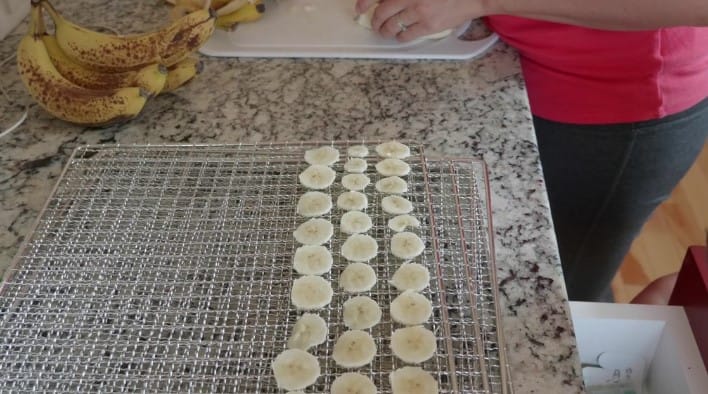 Dehydration is the oldest and most natural form of food preservation in the world. At some point, some humans left vegetables or meat on a hot rock in the hot sun, and all the moisture evaporated out of it. It became as hard as a rock, probably. Maybe it was smashed between two stones to make smaller pieces. At some point, early humans realized rehydration was possible. They probably made this discovery in their mouths. Then the dried pieces may have been thrown in water, and the dehydrated were rehydrated. They may have also noticed that the harder, dry version of foods was less susceptible to insects and critters and didn’t spoil or go rancid as quickly. Dehydration wasn’t invented in modern times despite what late-night infomercials might want you to believe. It was discovered around the same time man started eating.
This blog will explore the basics of everything you need to know to dehydrate food and why you should understand the science. We will use two different types of dehydrators, the sun, and oven, to demonstrate that the type of dehydrator isn’t as much a factor as what you are dehydrating. We’ll take a quick look at freeze-drying, which is a new technology available at home. By the end of this blog, you will know the basics of dehydration to the extent that you can do it yourself.
WHY DEHYDRATE?
Dehydration is the oldest and most natural form of food preservation in the world. At some point, some humans left vegetables or meat on a hot rock in the hot sun, and all the moisture evaporated out of it. It became as hard as a rock, probably. Maybe it was smashed between two stones to make smaller pieces. At some point, early humans realized rehydration was possible. They probably made this discovery in their mouths. Then the dried pieces may have been thrown in water, and the dehydrated were rehydrated. They may have also noticed that the harder, dry version of foods was less susceptible to insects and critters and didn’t spoil or go rancid as quickly. Dehydration wasn’t invented in modern times despite what late-night infomercials might want you to believe. It was discovered around the same time man started eating.
This blog will explore the basics of everything you need to know to dehydrate food and why you should understand the science. We will use two different types of dehydrators, the sun, and oven, to demonstrate that the type of dehydrator isn’t as much a factor as what you are dehydrating. We’ll take a quick look at freeze-drying, which is a new technology available at home. By the end of this blog, you will know the basics of dehydration to the extent that you can do it yourself.
WHY DEHYDRATE?
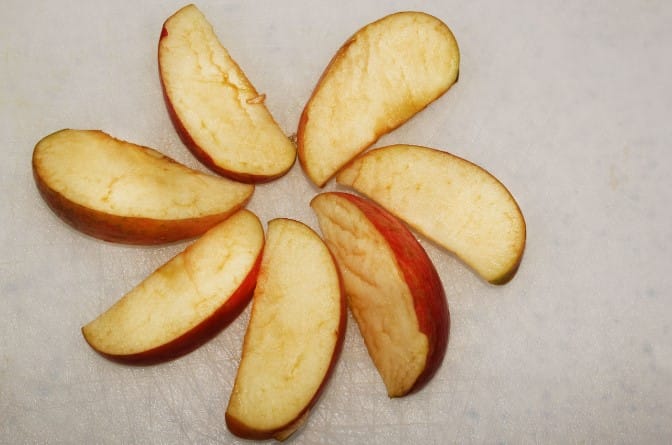 Dehydration of food is the gentle application of heat to reduce the moisture content of food. This allows it to last much longer. Dehydrating food reduces the moisture content to between 5 and 20%. At that level, the bacterium that causes food to decay can’t move around or propagate effectively. It either dies or goes dormant. It doesn’t entirely die, and dehydrated food still has a usable shelf-life and is susceptible to rehydration by moisture in the air. However, the process of decay is slowed to a crawl through the use of dehydration. Dehydration is the fastest, simplest, and least expensive way to preserve food. If you have a productive garden or need to set food aside to survive a winter, you need to know the basics of dehydration which I will cover here. The simple fact is that you can’t eat an entire harvest of any plant before it goes bad. Preserving food is the key to having food in the future.
Dehydration does have a few drawbacks, however. First, applying gentle heat to free up the water molecules in the food and encourage them to evaporate will also reduce the nutritional value of the food by up to 40%. This will vary depending upon the type of food and the bio-availability of the nutrients in the food, but it is still something to note. Second, the rehydration process requires water from an outside source, or it will need the water in your body to rehydrate. From a prepping standpoint, a dehydrated food diet will require you to increase your water consumption. Third, the texture and the taste of food are altered from its fresh form because the application of heat is gently cooking the food. Still, even with the slight reduction in the quality of nutrition, the need for water, and the altered, slightly cooked texture and taste, the huge benefit is food that, depending upon the type and the storage, can last 4-years or longer.
THE PROCESS & SCIENCE
Dehydration of food is the gentle application of heat to reduce the moisture content of food. This allows it to last much longer. Dehydrating food reduces the moisture content to between 5 and 20%. At that level, the bacterium that causes food to decay can’t move around or propagate effectively. It either dies or goes dormant. It doesn’t entirely die, and dehydrated food still has a usable shelf-life and is susceptible to rehydration by moisture in the air. However, the process of decay is slowed to a crawl through the use of dehydration. Dehydration is the fastest, simplest, and least expensive way to preserve food. If you have a productive garden or need to set food aside to survive a winter, you need to know the basics of dehydration which I will cover here. The simple fact is that you can’t eat an entire harvest of any plant before it goes bad. Preserving food is the key to having food in the future.
Dehydration does have a few drawbacks, however. First, applying gentle heat to free up the water molecules in the food and encourage them to evaporate will also reduce the nutritional value of the food by up to 40%. This will vary depending upon the type of food and the bio-availability of the nutrients in the food, but it is still something to note. Second, the rehydration process requires water from an outside source, or it will need the water in your body to rehydrate. From a prepping standpoint, a dehydrated food diet will require you to increase your water consumption. Third, the texture and the taste of food are altered from its fresh form because the application of heat is gently cooking the food. Still, even with the slight reduction in the quality of nutrition, the need for water, and the altered, slightly cooked texture and taste, the huge benefit is food that, depending upon the type and the storage, can last 4-years or longer.
THE PROCESS & SCIENCE
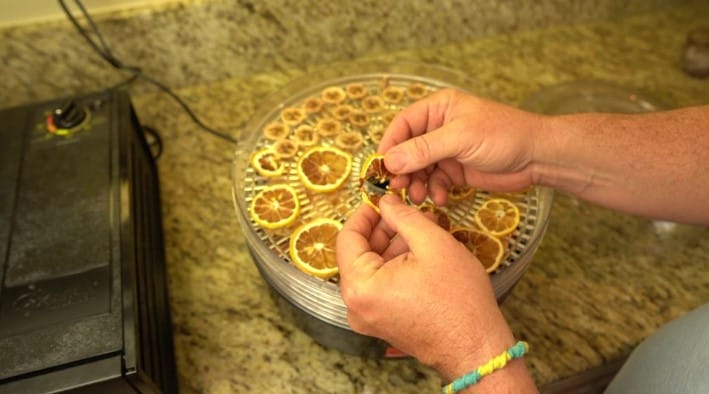 The water molecules are released when you dehydrate, and the remaining cells tighten up. This usually results in flavors intensifying. It can also result in pesticides concentrating. It can result in any bacteria or yeast on the surface not dying off entirely but going dormant. This is why the first rule of dehydration is proper food handling. If you haven’t seen the plant growing and don’t know how it was tended, you absolutely have to wash your food.
The next step in the process is to slice or deconstruct the food to be dehydrated into smaller pieces. The thinner the piece, the quicker the dehydration process. Some foods that are too thick will experience a drying of the outside, making it difficult to push the moisture through the dehydration process out of the center. When you utilize thin cuts, you expedite the drying process. As an example, here are some bananas that we attempted to dehydrate when they were too thick. You can see how the center was still soft, even hollowed out, because the cells on the outside became too compacted to allow moisture through easily. This can cause your food to rot from within, so you always want to slice food you intend to dehydrate thinly.
Heat should be above 130 degrees Fahrenheit, 54.44 degrees Celsius, to coax the moisture out of the food. Meats should be dehydrated at no less than 150 degrees Fahrenheit, 65.5 degrees Celsius. When you think of heat in dehydration, you want the temperature to maximize the dehydration process and to be fast enough to reduce the moisture in the food before mold, bacteria, or yeast can take hold of the food. Your heat should be sufficient to outrun the pathogens that might take hold but low enough to not alter the flavors, color, or texture by cooking it. Dry heat with adequate airflow is optimal over humidity and fluctuating temperatures.
Appearance is also a factor. Foods that have a high starch content will oxidize when exposed to oxygen. This is apparent when bananas, potatoes, or apples are cut and left exposed to the air. They will take on a brownish even grey tint and lose their appetizing, fresh appearance. The simple solution to this is to give oxidizing fruits and vegetables a couple of minutes of soak in a water bath with a couple of tablespoons of lemon juice in it. Lemon juice has ascorbic acid in it, which has an oxidation-reduction property. This will help to maintain the original color of the food. The acid keeps the fruit from oxidizing, so you could also use a couple of tablespoons of distilled vinegar for the same result.
As for the science, dehydration works through the application of low heat and steady airflow. The moisture in the food evaporates off, inhibiting the growth of bacteria, yeast, and mold. Fruits and vegetables are between 80 and 95% water, and meats are between 50 and 75% water. The dehydration process reduces this moisture content to below 20% and reduces water activity, the ability for water to move between cell membranes to between 0.00 and .60. If water activity is reduced in such a way, bacteria, yeast, and mold cannot take hold. However, the loss of that moisture also causes the cells to compact. This can result in a chewy, crunchy, and shriveled final product. Fear not, though. The cell walls remain largely intact and will take water back into them during the rehydration process.
TYPES OF DEHYDRATION
SOLAR, AIR DRYING, & OVEN
The water molecules are released when you dehydrate, and the remaining cells tighten up. This usually results in flavors intensifying. It can also result in pesticides concentrating. It can result in any bacteria or yeast on the surface not dying off entirely but going dormant. This is why the first rule of dehydration is proper food handling. If you haven’t seen the plant growing and don’t know how it was tended, you absolutely have to wash your food.
The next step in the process is to slice or deconstruct the food to be dehydrated into smaller pieces. The thinner the piece, the quicker the dehydration process. Some foods that are too thick will experience a drying of the outside, making it difficult to push the moisture through the dehydration process out of the center. When you utilize thin cuts, you expedite the drying process. As an example, here are some bananas that we attempted to dehydrate when they were too thick. You can see how the center was still soft, even hollowed out, because the cells on the outside became too compacted to allow moisture through easily. This can cause your food to rot from within, so you always want to slice food you intend to dehydrate thinly.
Heat should be above 130 degrees Fahrenheit, 54.44 degrees Celsius, to coax the moisture out of the food. Meats should be dehydrated at no less than 150 degrees Fahrenheit, 65.5 degrees Celsius. When you think of heat in dehydration, you want the temperature to maximize the dehydration process and to be fast enough to reduce the moisture in the food before mold, bacteria, or yeast can take hold of the food. Your heat should be sufficient to outrun the pathogens that might take hold but low enough to not alter the flavors, color, or texture by cooking it. Dry heat with adequate airflow is optimal over humidity and fluctuating temperatures.
Appearance is also a factor. Foods that have a high starch content will oxidize when exposed to oxygen. This is apparent when bananas, potatoes, or apples are cut and left exposed to the air. They will take on a brownish even grey tint and lose their appetizing, fresh appearance. The simple solution to this is to give oxidizing fruits and vegetables a couple of minutes of soak in a water bath with a couple of tablespoons of lemon juice in it. Lemon juice has ascorbic acid in it, which has an oxidation-reduction property. This will help to maintain the original color of the food. The acid keeps the fruit from oxidizing, so you could also use a couple of tablespoons of distilled vinegar for the same result.
As for the science, dehydration works through the application of low heat and steady airflow. The moisture in the food evaporates off, inhibiting the growth of bacteria, yeast, and mold. Fruits and vegetables are between 80 and 95% water, and meats are between 50 and 75% water. The dehydration process reduces this moisture content to below 20% and reduces water activity, the ability for water to move between cell membranes to between 0.00 and .60. If water activity is reduced in such a way, bacteria, yeast, and mold cannot take hold. However, the loss of that moisture also causes the cells to compact. This can result in a chewy, crunchy, and shriveled final product. Fear not, though. The cell walls remain largely intact and will take water back into them during the rehydration process.
TYPES OF DEHYDRATION
SOLAR, AIR DRYING, & OVEN
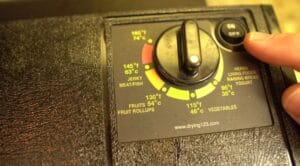 The oldest method of dehydration is solar air drying. As this requires outdoor exposure to the sun, protecting the food from insects and critters is essential. This is usually accomplished with a vented cover or drying the food between screens. This method works the fastest with leafy plants and will take longer, perhaps more than a day, for fruits, vegetables, and meats. The sun’s activity limits you. You can maximize the sun’s activity through a solar cooker or reflective materials to concentrate the heat and expedite the evaporation process. Absent the sun’s drying effect, you can dehydrate simply by leaving anything exposed to dry heat and protected from airborne food spoilers and insects. You want the air warm and dry. Humidity will significantly reduce your ability to dehydrate anything. In the days of ovens with pilot lights, many people dehydrated simply by cutting the food and leaving it in the oven with the door closed. Even today, you can dehydrate food in the oven, and I often do when making jerky. However, the problem with this method is that many modern ranges won’t go below 175 degrees. Some do have a warming setting, though, and some people find the lowest setting on their oven, then simply prop the door open slightly to vent off excess heat. The oven works best with foods that can handle higher temperatures in the dehydration process. For more delicate foods with more delicate cell walls, you can dehydrate by warming your oven, turning it off, putting the food in with the door closed, then repeating the process when the oven comes back down in temperature until the food is dry. In my video on making the Ultimate Jerky, we use an air-fryer, dehydrator, and oven to make jerky and compare the results. We will link to that blog if you are interested in learning more.
Since you essentially just need low heat, circulating air, and access to the sun, there are many build your own plans for solar dehydrators online. If you feel crafty, it’s a great addition to your preps or a great Cub Scouts project. At the very least, it wouldn’t hurt to have a printed copy of the plans in your prepper library.
MICROWAVE DEHYDRATION
The oldest method of dehydration is solar air drying. As this requires outdoor exposure to the sun, protecting the food from insects and critters is essential. This is usually accomplished with a vented cover or drying the food between screens. This method works the fastest with leafy plants and will take longer, perhaps more than a day, for fruits, vegetables, and meats. The sun’s activity limits you. You can maximize the sun’s activity through a solar cooker or reflective materials to concentrate the heat and expedite the evaporation process. Absent the sun’s drying effect, you can dehydrate simply by leaving anything exposed to dry heat and protected from airborne food spoilers and insects. You want the air warm and dry. Humidity will significantly reduce your ability to dehydrate anything. In the days of ovens with pilot lights, many people dehydrated simply by cutting the food and leaving it in the oven with the door closed. Even today, you can dehydrate food in the oven, and I often do when making jerky. However, the problem with this method is that many modern ranges won’t go below 175 degrees. Some do have a warming setting, though, and some people find the lowest setting on their oven, then simply prop the door open slightly to vent off excess heat. The oven works best with foods that can handle higher temperatures in the dehydration process. For more delicate foods with more delicate cell walls, you can dehydrate by warming your oven, turning it off, putting the food in with the door closed, then repeating the process when the oven comes back down in temperature until the food is dry. In my video on making the Ultimate Jerky, we use an air-fryer, dehydrator, and oven to make jerky and compare the results. We will link to that blog if you are interested in learning more.
Since you essentially just need low heat, circulating air, and access to the sun, there are many build your own plans for solar dehydrators online. If you feel crafty, it’s a great addition to your preps or a great Cub Scouts project. At the very least, it wouldn’t hurt to have a printed copy of the plans in your prepper library.
MICROWAVE DEHYDRATION
 Obviously, you wouldn’t have this method available to you if the grid goes down, but microwave dehydration is possible. You should use the absolute lowest setting on your microwave to accomplish this, which may be your defrost at the lowest setting. Some microwaves have a 10% or low setting on them. Herbs and leafy vegetables will be done in less than 5 minutes. Fruits can take as much as a half-hour. This works because the microwaves agitate the water molecules and cause them to gas off in the evaporation process. Even on the lowest setting, though, some food cooking can occur. We have used this method for herbs I want to dehydrate and preserve, but it isn’t my preferred method. We find that fruit and vegetables just take too long and slightly cook, and we have never seen any meat that dehydrates well with this method. The microwave cooks the meat even on the lowest setting. The rapid application of heat, even at the lowest setting, tightens the proteins in the meat too much, rendering it crunchy, cooked, and, in my opinion, inedible.
ELECTRIC DEHYDRATION
Obviously, you wouldn’t have this method available to you if the grid goes down, but microwave dehydration is possible. You should use the absolute lowest setting on your microwave to accomplish this, which may be your defrost at the lowest setting. Some microwaves have a 10% or low setting on them. Herbs and leafy vegetables will be done in less than 5 minutes. Fruits can take as much as a half-hour. This works because the microwaves agitate the water molecules and cause them to gas off in the evaporation process. Even on the lowest setting, though, some food cooking can occur. We have used this method for herbs I want to dehydrate and preserve, but it isn’t my preferred method. We find that fruit and vegetables just take too long and slightly cook, and we have never seen any meat that dehydrates well with this method. The microwave cooks the meat even on the lowest setting. The rapid application of heat, even at the lowest setting, tightens the proteins in the meat too much, rendering it crunchy, cooked, and, in my opinion, inedible.
ELECTRIC DEHYDRATION
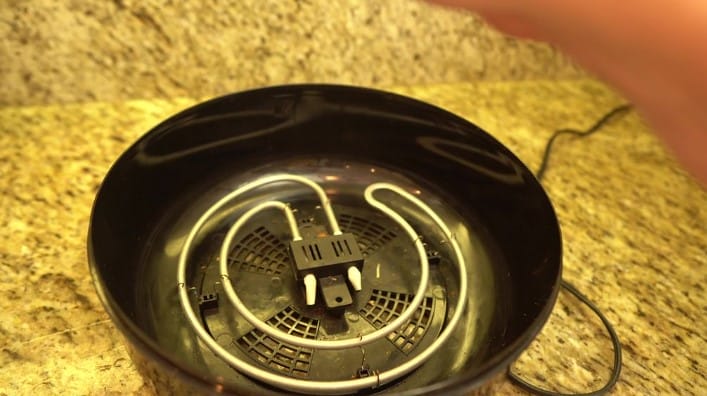 Electric dehydration better controls the steady application of heat and airflow, eliminating temperature and humidity fluctuations. This is why it is the preferred method for most people and the method we will demonstrate here. Any way that works to provide gentle heat and consistent airflow will work. You can dehydrate on a warm rock next to a fire if that’s all you have, but electric dehydrators allow you to regulate airflow and heat settings better. This gives you optimal control over the dehydration process. Rather than tend a fire, constantly adjust a solar dehydrator to properly align with the sun, or mess with the dials and buttons of a stove or a microwave, you can use an electric dehydrator to set it and forget it, as they say.
For this dehydration journey, we will use a high-end Excaliber Dehydrator with controls to allow me to adjust the heat and airflow and my old reliable heating coil and airflow dehydrator. We have done this before, and if you watch some of my other videos, you will know which one of these we prefer and grab most often, but let’s put them both to the test here. We will be freeze-drying blackberries, strawberries, apples, citrus, and bananas. Again, if you’d like to see dehydrators used for meat, take a look at my Ultimate Jerky video linked in the comments. When it comes to foods, dehydrators will work well with fruits, vegetables, breads, meats, herbs, and sprouted grains. You can dehydrate other things, but these foods give you the best quality.
PREPPING THE FOOD
Electric dehydration better controls the steady application of heat and airflow, eliminating temperature and humidity fluctuations. This is why it is the preferred method for most people and the method we will demonstrate here. Any way that works to provide gentle heat and consistent airflow will work. You can dehydrate on a warm rock next to a fire if that’s all you have, but electric dehydrators allow you to regulate airflow and heat settings better. This gives you optimal control over the dehydration process. Rather than tend a fire, constantly adjust a solar dehydrator to properly align with the sun, or mess with the dials and buttons of a stove or a microwave, you can use an electric dehydrator to set it and forget it, as they say.
For this dehydration journey, we will use a high-end Excaliber Dehydrator with controls to allow me to adjust the heat and airflow and my old reliable heating coil and airflow dehydrator. We have done this before, and if you watch some of my other videos, you will know which one of these we prefer and grab most often, but let’s put them both to the test here. We will be freeze-drying blackberries, strawberries, apples, citrus, and bananas. Again, if you’d like to see dehydrators used for meat, take a look at my Ultimate Jerky video linked in the comments. When it comes to foods, dehydrators will work well with fruits, vegetables, breads, meats, herbs, and sprouted grains. You can dehydrate other things, but these foods give you the best quality.
PREPPING THE FOOD
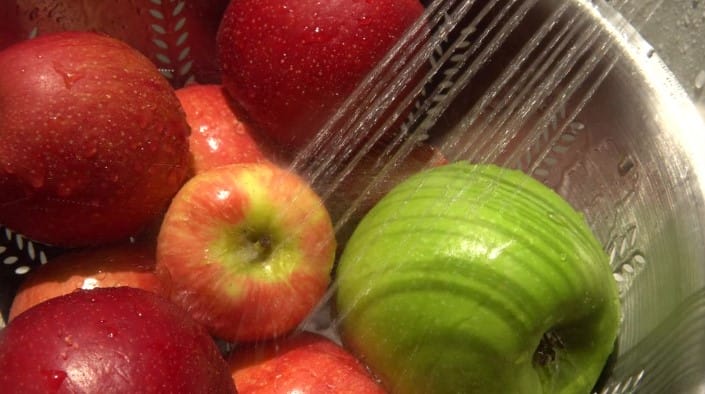 We rinse all food even if I grew it organically myself. You should see some bugs that come off food from the garden. That’s just what you can see, too. Commercial foods are often sprayed with copious amounts of pesticides, sprouting inhibitors, and God knows what. Rinse your food and allow it to air dry on a towel or paper towel. Slice fruits and vegetables into uniform slices no greater than 1/8th to a 1/4 inch. The smaller and thinner, the better. For the apples, we don’t even bother to core them, as I can run them over the Mandolin and get great uniform slices that will dry quickly. You can use a food processor or grater to process fruits and vegetables. You can leave the skins on or remove them. You can cut them into cored wedges or chunks. There isn’t a wrong way to do this unless your pieces are of varying sizes or too thick to allow all the moisture to escape. We soak them in water with lemon juice added to prevent them from browning, then I spread them in the Excalibur and Ronco dehydrators and put some in the oven on the warm setting.
For the strawberries, we slice them into uniform sizes. We do the same with the bananas. We will also give the bananas a lemon water soak, but they will still brown a little in the process. For the blackberries, we slice them in half to allow greater exposure to the moisture locked inside. We cut the lemons in uniform pieces, as well, and placed them on the trays. Some discoloration will occur. In dehydration, the moisture is gradually evaporating. Here we have to mention freeze-drying because this is dehydration taken to the next level. When the food is flash frozen and then put in the vacuum chamber of a freeze dryer and gently warmed, the water gasses rapidly off the food. It sublimates at a much more efficient rate. 99% of the moisture is removed, making it lighter and longer-lasting. This results in super-low moisture dehydrated, freeze-dried product with an effective shelf life of up to 25-years. The food also retains color, flavor, and as close to original nutritional value as scientifically possible. The problem for many with freeze-drying, though, is the machine for residential use has a hefty price tag. A counter-top dehydrator can be had for under $50. It all comes down to what you want to dehydrate, how often you will be using the machine, and what quantities you want. We have blogs on my channel that address all of these. We will link to the three different devices we use to build my food preps in the comments below but leave it to you to determine what fits your desired lifestyle and needs best.
If you are dehydrating potatoes or are concerned about the color of your food, you can blanch vegetables by steaming them for 2-5 minutes or dropping them in boiling water for around a minute. This will keep the vegetables from oxidizing and color-changing without cooking them entirely. There are preservatives like ascorbic acid and citric acid. However, we are using lemon juice as an unrefined source of these, fruit juice, and sodium bisulfite, which the foods can be dipped in before dehydration. These will extend shelf life.
For meats, it is suggested that you heat the meat to the temperature needed to kill pathogens, then dehydrate it at the lower temperature. The addition of salts or smoke also kills pathogens. It is further suggested that you don’t dehydrate pork, unless it is already cured or chicken unless it is already cooked. The risk of food-borne pathogens is too significant. Always dehydrate meats at a temperature around 160 degrees. The lowest setting on my oven is 175, and we have had good success with oven jerky.
Before dehydrating, some people add a little salt or sugar or seasoning or flavored oil to their food. That’s fine. Just take into account that removing the water from the food will tighten cell structures, concentrate, and intensify flavors, so a little goes a long way.
RESULTS
We rinse all food even if I grew it organically myself. You should see some bugs that come off food from the garden. That’s just what you can see, too. Commercial foods are often sprayed with copious amounts of pesticides, sprouting inhibitors, and God knows what. Rinse your food and allow it to air dry on a towel or paper towel. Slice fruits and vegetables into uniform slices no greater than 1/8th to a 1/4 inch. The smaller and thinner, the better. For the apples, we don’t even bother to core them, as I can run them over the Mandolin and get great uniform slices that will dry quickly. You can use a food processor or grater to process fruits and vegetables. You can leave the skins on or remove them. You can cut them into cored wedges or chunks. There isn’t a wrong way to do this unless your pieces are of varying sizes or too thick to allow all the moisture to escape. We soak them in water with lemon juice added to prevent them from browning, then I spread them in the Excalibur and Ronco dehydrators and put some in the oven on the warm setting.
For the strawberries, we slice them into uniform sizes. We do the same with the bananas. We will also give the bananas a lemon water soak, but they will still brown a little in the process. For the blackberries, we slice them in half to allow greater exposure to the moisture locked inside. We cut the lemons in uniform pieces, as well, and placed them on the trays. Some discoloration will occur. In dehydration, the moisture is gradually evaporating. Here we have to mention freeze-drying because this is dehydration taken to the next level. When the food is flash frozen and then put in the vacuum chamber of a freeze dryer and gently warmed, the water gasses rapidly off the food. It sublimates at a much more efficient rate. 99% of the moisture is removed, making it lighter and longer-lasting. This results in super-low moisture dehydrated, freeze-dried product with an effective shelf life of up to 25-years. The food also retains color, flavor, and as close to original nutritional value as scientifically possible. The problem for many with freeze-drying, though, is the machine for residential use has a hefty price tag. A counter-top dehydrator can be had for under $50. It all comes down to what you want to dehydrate, how often you will be using the machine, and what quantities you want. We have blogs on my channel that address all of these. We will link to the three different devices we use to build my food preps in the comments below but leave it to you to determine what fits your desired lifestyle and needs best.
If you are dehydrating potatoes or are concerned about the color of your food, you can blanch vegetables by steaming them for 2-5 minutes or dropping them in boiling water for around a minute. This will keep the vegetables from oxidizing and color-changing without cooking them entirely. There are preservatives like ascorbic acid and citric acid. However, we are using lemon juice as an unrefined source of these, fruit juice, and sodium bisulfite, which the foods can be dipped in before dehydration. These will extend shelf life.
For meats, it is suggested that you heat the meat to the temperature needed to kill pathogens, then dehydrate it at the lower temperature. The addition of salts or smoke also kills pathogens. It is further suggested that you don’t dehydrate pork, unless it is already cured or chicken unless it is already cooked. The risk of food-borne pathogens is too significant. Always dehydrate meats at a temperature around 160 degrees. The lowest setting on my oven is 175, and we have had good success with oven jerky.
Before dehydrating, some people add a little salt or sugar or seasoning or flavored oil to their food. That’s fine. Just take into account that removing the water from the food will tighten cell structures, concentrate, and intensify flavors, so a little goes a long way.
RESULTS
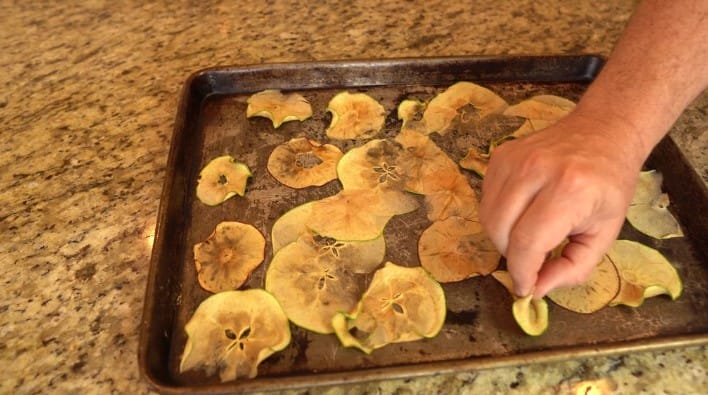 At close to the 24-hour mark, my super thin apple slices were pretty much dry. They’ll keep for a few weeks like this, no problem. If I give them another 24-hours and try and get them even drier, pack them in a jar with an oxygen absorber, We can stretch their shelf-life out for months. Dehydrated fruits and vegetables will need moisture to allow mold, yeast, or bacteria to take hold. The mold you will see and the yeast you will smell and taste on fruits and vegetables long before bacteria really takes hold. You can boil the food for 10 minutes to render it edible by killing any pathogens in an emergency.
At its warming setting, my oven will take much longer than the electric or solar methods. When applied to herbs, the microwave method ended up cooking the herbs slightly. That degrades the flavors and colors considerably. To be honest, we have never really had success with the microwave method, but some people frequently use this method. The real test, for me, was between the electric dehydrator without and with temperature controls. We usually default to my non-control dehydrator, and you can regulate the temperature a little with the top valve on the lid. Still, the lemons took on a slightly cooked flavor. The Excaliber, where we were able to dial in the temperature, retained all the flavors of the lemons. Our preferred method for lemons is still my freeze-dryer, but the Excalibur or solar dehydrator will work in a pinch.
The primary key to optimal dehydration is to remove moisture as quickly as possible at a temperature that does not seriously affect the food’s flavor, texture, and color. So, it comes down to time and money. If you have the time and space to build a solar dehydrator, you will get the best results by manually regulating sun exposure. We would pass altogether on the microwave method, but if this works for you, please give us some tips and tricks in the comments below. Either of the electric dehydrators will work best, but the more temperature control you have, the better flavors you will be able to retain. And, the oven, well…It’s still working on those fruits while we are wrapping up this blog. And, of course, for the most extended shelf life and retention of nutrients and flavors, freeze-drying is the way to go, but the cost is a prominent detractor for many people.
What do you dehydrate? Let us know in the comments below. Check out our other blogs on dehydrating and the Ultimate Jerky to understand even more about the art of dehydrating. Whatever you do, get some dehydrated or freeze-dried foods in your prepping pantry. As a food preservation method, dehydration of foods is the oldest method out there. The effectiveness is greatly enhanced depending upon the freeze dryer you use. If your climate isn’t very sunny, you may have no other option but electric or an oven. In a grid-down situation, you may have no choice but to use solar.
As always, stay safe out there.
Reference Links:
Build Your Own Solar Dehydrator: https://www.homedepot.com/c/ah/diy-dehydrator/9ba683603be9fa5395fab9044393cfc
5-Tray Dehydrator (no temperature dial) – https://amzn.to/3jglTKI
Excalibur w/thermostat control dial – https://amzn.to/3uibPa6
HarvestRight: https://bit.ly/2YYjjCw
At close to the 24-hour mark, my super thin apple slices were pretty much dry. They’ll keep for a few weeks like this, no problem. If I give them another 24-hours and try and get them even drier, pack them in a jar with an oxygen absorber, We can stretch their shelf-life out for months. Dehydrated fruits and vegetables will need moisture to allow mold, yeast, or bacteria to take hold. The mold you will see and the yeast you will smell and taste on fruits and vegetables long before bacteria really takes hold. You can boil the food for 10 minutes to render it edible by killing any pathogens in an emergency.
At its warming setting, my oven will take much longer than the electric or solar methods. When applied to herbs, the microwave method ended up cooking the herbs slightly. That degrades the flavors and colors considerably. To be honest, we have never really had success with the microwave method, but some people frequently use this method. The real test, for me, was between the electric dehydrator without and with temperature controls. We usually default to my non-control dehydrator, and you can regulate the temperature a little with the top valve on the lid. Still, the lemons took on a slightly cooked flavor. The Excaliber, where we were able to dial in the temperature, retained all the flavors of the lemons. Our preferred method for lemons is still my freeze-dryer, but the Excalibur or solar dehydrator will work in a pinch.
The primary key to optimal dehydration is to remove moisture as quickly as possible at a temperature that does not seriously affect the food’s flavor, texture, and color. So, it comes down to time and money. If you have the time and space to build a solar dehydrator, you will get the best results by manually regulating sun exposure. We would pass altogether on the microwave method, but if this works for you, please give us some tips and tricks in the comments below. Either of the electric dehydrators will work best, but the more temperature control you have, the better flavors you will be able to retain. And, the oven, well…It’s still working on those fruits while we are wrapping up this blog. And, of course, for the most extended shelf life and retention of nutrients and flavors, freeze-drying is the way to go, but the cost is a prominent detractor for many people.
What do you dehydrate? Let us know in the comments below. Check out our other blogs on dehydrating and the Ultimate Jerky to understand even more about the art of dehydrating. Whatever you do, get some dehydrated or freeze-dried foods in your prepping pantry. As a food preservation method, dehydration of foods is the oldest method out there. The effectiveness is greatly enhanced depending upon the freeze dryer you use. If your climate isn’t very sunny, you may have no other option but electric or an oven. In a grid-down situation, you may have no choice but to use solar.
As always, stay safe out there.
Reference Links:
Build Your Own Solar Dehydrator: https://www.homedepot.com/c/ah/diy-dehydrator/9ba683603be9fa5395fab9044393cfc
5-Tray Dehydrator (no temperature dial) – https://amzn.to/3jglTKI
Excalibur w/thermostat control dial – https://amzn.to/3uibPa6
HarvestRight: https://bit.ly/2YYjjCw 
